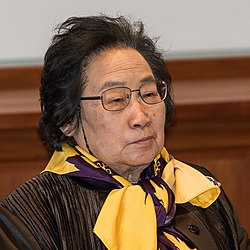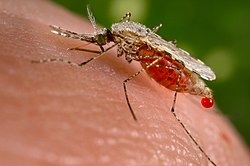Tu Youyou
| It matters Chemistry |
| Action and reaction |
| Elementary! |
| Spooky scary chemicals |
| Er, who's got the pox? |
Tu Youyou[note 1] (30 December 1930–) is a Chinese chemist and scientist best known for her work related to artemisinin, a chemical compound used to treat malaria around the world. For this, she received the Nobel Prize in Physiology or Medicine.[1] She and a team of researchers discovered artemisinin during the turbulent Cultural Revolution in China at the China Academy of Traditional Chinese Medicine. The artemisinin was extracted from Artemisia annua![]() (sweet wormwood), which they discovered was used in traditional Chinese medicine to treat fever. She is still currently researching malaria, fearing that the plasmodia parasite may become drug resistant to artemisinin, thus undoing much of her and others' work.[2]
(sweet wormwood), which they discovered was used in traditional Chinese medicine to treat fever. She is still currently researching malaria, fearing that the plasmodia parasite may become drug resistant to artemisinin, thus undoing much of her and others' work.[2]
Malaria[edit]
Malaria has been a difficult disease to tackle historically. It has plagued tropical and semi-tropical regions, killing large numbers of people. Cures were generally difficult to come by and mortality rates were high, especially for infants and children. Symptoms include vomiting, fever, excessive sweating, and painful headaches. In 2017, there were over 219 million cases worldwide, resulting in over 400,000 deaths, 90% of these deaths being in Africa.[3] The disease is commonly acquired through being bitten by a mosquito, but the mosquito itself doesn't cause the disease; rather, unicellular eukaryotes of the Plasmodium genus transmitted via the bite do. Historically, due to the anti-drug resistance of malaria, preventive measures have been common, including the controversial use of pest control agents like DDT spraying. Less controversial methods include the draining of swamps and use of (DDT-infused) mosquito nets.
Quinine[edit]
The first established treatments for malaria were Cinchona tree bark and quinine extracted from the bark. Quechua-speaking people in South America used to chew on the bark of the tree to alleviate pain.[4] Europeans knew of its medicinal benefits as early as the 1570s and by the 1820s had extracted quinine from the tree itself. Quinine played a major role in reducing mortality from malaria in the tropics[5], but it came with a number of problematic side effects not found in artemisinin like headaches, irregular heartbeat, or excessive sweating. Most troubling, there are instances where malaria is quinine resistant.[6] Subsequently, many anti-malarial drugs were synthesized in the 20th century.
Sweet wormwood[edit]
Tu's achievement was impressive for many reasons.[note 2] She had to review thousands of different types of potential cures from a large volume of traditional medical references, most of which did not yield any results. She had no Ph.D. (none were given in China during her youth), she had little access to scientific research from outside China, and during the Cultural Revolution, China was a place that was generally hostile to intellectuals and did not foster a very nurturing environment for scientists to work. In spite of this, she was appointed to the head of a research team tasked with finding a cure for malaria, a major problem in southern and southeast Asia. An old manuscript that described a recipe used to treat fevers seemed promising, so they attempted to replicate it. At first, they did not succeed because they attempted to extract the medicinal substance from sweet wormwood with boiling water which destroyed the healing properities of the wormwood. Tu eventually refined their extraction process and used cooler water to soak the wormwood which allowed them to acquire the artemisinin. Over time, its medicinal properties were realized in terms of its effectiveness in combating parasites and bacterial infections. Millions of people have been saved by the discovery, or had their health dramatically improved.[7][8] Decades later, Tu's work is not finished, as she continues to study malaria and methods of combating it.
Notes[edit]
References[edit]
- ↑ "The Nobel Prize in Physiology or Medicine 2015". NobelPrize.org.
- ↑ "Nobel Prize winner may have found solution to malaria drug resistance". South China Morning Post. 17 June 2019. Retrieved 6 January 2020.
- ↑ "Fact sheet about Malaria". www.who.int. Retrieved 6 January 2020.
- ↑ Quinine Sulfate Drugs.com
- ↑ Maddison, A. (2007). Contours of the world economy 1-2030 AD: Essays in macro-economic history. Oxford University Press.
- ↑ Quinine Sulfate Drugs.com
- ↑ Mckenna, Phil. "Nobel Prize goes to modest woman who beat malaria for China". New Scientist. Retrieved 2020-01-06.
- ↑ Frieden, Tom. "Tu Youyou: The World's 100 Most Influential People". TIME.com. Retrieved 2020-01-06.

